Abstract
Pollution and the increase in greenhouse gas (GHG) emissions have long been linked to the world’s increasing need for fossil fuels to generate energy. Every day, the energy consumption is increasing; therefore, it is important to improve technologies that use renewable energy sources. With the abundant availability of sustainable energy, solar power is becoming a necessity. However, solar energy has a low energy density and therefore requires a large installation area, which requires heat collection and heat storage technology. Much research is now being done on the conical solar systems to improve efficiency including calculating an optimal cone angle, finding the best flow ratio and the best absorber design, etc. Therefore, in this study, thermal performance of a conical solar collector (CSC) was assessed with a new design of concentric tube absorber (addition of a coil) and compared to the existing circular tube absorber. It was found that 6 L/min flow rate of heating medium (distilled water and CuO nanofluid) gave lower payback period and higher solar fraction of the system in both cases of absorber tube, i.e., without coil and with coil. However, comparatively, thermal efficiency of CSC with coil-based absorber was almost 10–12% higher than conventional system (without coil) regardless of type of heating medium used.
1. Introduction
The need for renewable energy is increasing due to increasing industrialization and the over use of fossil fuels, both of which have negative consequences for global climate change. Solar energy is one of the cleanest, most plentiful, and environmentally friendly renewable energy sources. Solar water heaters of various configurations and designs have been utilized for diverse purposes to extract the thermal energy from incoming solar radiation [1]. Recent progressive development of modern technology continues to increase human energy needs. Energy consumption and demand has been increasing worldwide, and researchers are involved in meeting future energy needs [2,3]. The current and expected energy sources are not sustainable such as nuclear power (5%), natural gas (22%), coal/peat (27%), and oil (32%) [1].
The consumption of oil, natural gas, coal and nuclear energy is very high compared to renewable energy, which ultimately leads to pollution problems such as acid rains, ozone layer depletion, and global climate change [4,5].
Renewable energy is a source of sustainable power generation and can potentially minimize pollution problems. The use of renewable energy has increased in recent years, but it is still not widespread. Solar energy is gaining popularity as an option to provide sustainable energy [6]. The most commonly used technologies to harness solar energy are photovoltaic (PV) technology to convert solar energy into electricity and solar thermal collectors to convert sunlight into heat. Solar heat can be used in various fields and has excellent economic advantages [7]. However, due to the low energy density, it is difficult to continuously use solar energy depending on the outdoor environment. The role of a concentrator or reflector is very important in solar concentrating systems. Concentrating solar collectors, which have higher concentration ratios than flat-plate collectors, are of particular interest to researchers. Most cylindrical and circular concentrators have been classified as either reflecting or refractive [6,7]. Various types of concentrators have been developed to date, such as: compound parabolic concentrators (CPC), parabolic trough concentrators (PTC), dish type, and conical solar concentrators [8,9,10,11,12]. Among the above concentration technologies, the conical solar concentrators are easier to manufacture and also possess the advantage of having a small heat loss area compared to other concentrating technologies. In addition, compared to a generally flat plate collector, the conical heat collection unit produces a significantly higher thermal efficiency [13].
Various researchers have investigated the performance of solar thermal collectors [14,15]. Zhai et al. [9], for example, conducted an experimental evaluation of a concentrating solar collector with a linear Fresnel lens, attempting to increase the collector’s thermal efficiency over a normal evacuated tube collector system. Kostic and Pavlovic [14] discovered that using solar radiation reflectors at a suitable angle improves the thermal efficiency of a thermal collector. Tao et al. [16] developed the computational and physical models to evaluate the coupled heat transfer performance of a solar dish collector system. To validate the test and model constraints, they examined five different types of solar thermal collector models under steady-state and quasi-dynamic situations [17].
A conical concentrator in a solar concentrating system that reflects the incident radiant flux onto an absorber positioned at the focal axis. Smith’s innovative conical surface collector [18] can achieve a high concentration ratio. Countless studies have reported solar concentrating systems for water heating, but only a handful have employed a conical concentrator with a dual-axis tracking system. Some researchers [19] discuss the usage of conical concentrators with one-dimensional tracking systems for air heating. Imtiaz Hussain et al. [20] tested the optical performance of a conical solar collector using stainless steel and aluminum mirror reflectors at different reflector view angles of 35°, 40°, and 45°. Results showed that the maximum thermal of solar collector was achieved at optimal reflector view angle of 45°. In another study [21], they discussed the challenges associated with non-uniformity of the solar flux distribution and its impacts on the temperature distribution in the axial and radial directions on the absorber surface of a conical solar collecting system. However, in the literature there is no example of the use of a conical solar concentrating system with an increase in the absorber area for water heating.
This study focuses on improving the thermal efficiency of the conical solar concentrating system by increasing the absorber surface area. Therefore, a copper coil was placed in the absorber. The proposed conical solar concentrating unit consists of a conical concentrator that collects solar radiation, a heat accumulator (absorber) that converts solar radiation into thermal energy, and a heat storage tank.
The overall aim of this research is to evaluate the efficiency improvement of the conical solar system by inserting a coil inside the concentric tube absorber and also the CuO nanofluid as a heating medium. To achieve these goals, the thermal efficiency of the conical solar collector with the existing absorber (without coil) was compared with the new coil-based absorber under similar operating conditions.
2. Materials and Methods
2.1. Conical Condensing System Configuration and Method
The conical concentrating system consists of a dual-axis tracking system equipped with a sun sensor and a drive shaft to track the sun as shown in Figure 1. During operation, the reflected solar radiations is intercepted via the conical concentrator by the coil-based absorber located at the focal axis of the reflector.
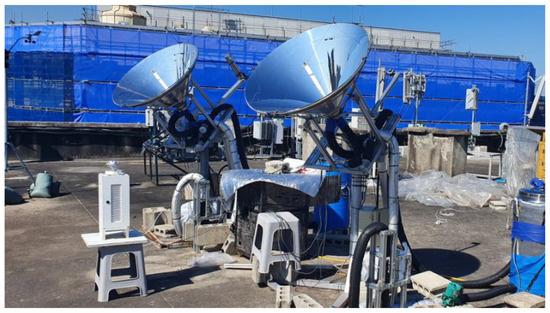
Figure 1.
Experimental setup of the conical solar collector system.
Mainly, the design parameters of the conical solar concentrating were adopted from the published study, as reported by Na et al. [12]. The reflector is made of stainless-steel having surface area of 0.785 m2. The concentration ratio of proposed reflector is 10. High-density energy is converted into heat by double tube absorbers and then transferred to the heating medium. A circulation pump is used to forcibly circulate the heating medium through the coil-based absorber to be heated, and finally, the heated fluid is stored in the heat storage tank. To measure the temperature of the heating medium, two temperature sensors (PT 100 Ω) were installed each at the inlet and outlet of the absorber tube. The amount of direct solar radiation and the outside air temperature were measured using preheliometer and thermocouples, respectively. All devices were connected to a computer via a data acquisition unit. To compare the collection efficiency, two conical condensing systems were built and tested.
2.2. Double Absorption Tube
In this study, a coil-based absorber was built and compared to the reference absorber (without coil). The difference between them occurs in the tubes where the copper coil has been added to increase the heat transfer efficiency by increasing the heat transfer surface area.
2.2.1. Existing Absorber Tube
The reference absorber contains two concentric tubes made of corrosion-resistant copper with high thermal conductivity. The two copper tubes are designed as double tubes for the circulation of the heating medium.
The concentric-tube absorber is attached centrally to the focal axis of the conical concentrator. To increase the absorption rate, the outer surface of the absorber was painted matt black. In addition, rubber insulation is provided at the bottom end to minimize heat loss transferred from the absorber tube. Figure 2 shows the details of the dimension, fluid flow direction, and image of the existing double tube absorber.
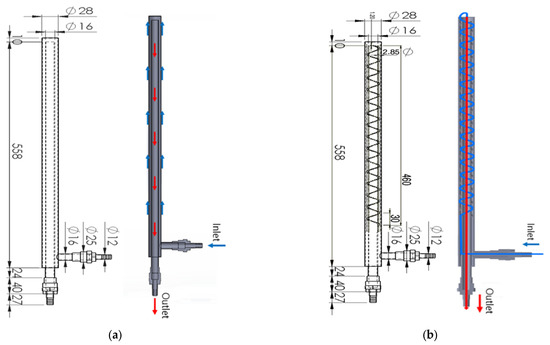
Figure 2.
Detail of existing absorber tube with and without coil. (a) Absorber tube without coil; (b) Absorber tube with coil.
2.2.2. Coil Based Absorber
For the comparison purpose, the dimension details were taken similar to the existing absorber tube. However, the changes occur inside the absorber tube by adding the copper coil between the inner and outer tubes. According to the convection heat transfer as presented in Equation (1), the rate of heat transfer (Q) will get high by enlarging the absorber surface area (A) that is in contact with the working fluid [22,23]. Due to its resistance to corrosion and high thermal conductivity, the coil was made from copper. Details of coil-based absorber are shown in Figure 2.
2.3. Nanofluid Manufacturing
In this study, the CuO nanofluid was prepared by using the two-step process. The specific heat was calculated from the measured values. Maintaining the dispersion stability in the nanofluids is very important to achieve the desired results. The nanofluid manufacturing process is generally divided into a two-stage process and a one-stage process. In the two-stage process, the production of nanoparticles and their dispersion in an available liquid take place separately [24]. This is a method of dispersing the prepared nanoparticles by adding ultrasonic energy to an available base fluid. The advantage of using this method is that it can be mass-produced. In this study, the two-step method was chosen, after adding 0.25 by weight of copper nanoparticles and surfactant with concentration to 400 mL of distilled water as the base liquid, the mixture was stirred for 30 min using a magnetic stirrer (KMC-130SH, VISION, Seoul, Korea). Furthermore, the colloidal solution was sonicated for 1 h and 30 min using an ultrasonic sonicator (KFS-1200N).
The thermal conductivity of the nanofluid was measured using a KD2 Pro Thermal Properties Analyzer (KD2, DRAGON, USA). As shown in Table 1, thermal conductivity of the nanofluids was analyzed by using different concentrations of surfactant as suggested by Abdalha Mahmood et al. [24]. Surfactants CTAB (Cetyltrimethylammonium bromide) and AG (Arabic Gum) were added to improve the stability of the resultant nanofluids. Since the nanofluid temperature rises after ultrasonic dispersion, therefore, for a while the mixture was placed indoors considering the measurement error. Thermal conductivity of the nanofluids was calculated by the following correlation [24]:
where represents the nanoparticles concentration and , and represent the thermal conductivity of the nanofluid, the base fluid, and of the nanoparticles, respectively.

Table 1.
Thermal conductivity of used nanofluid using different concentrations of surfactant.
2.4. Efficiency Calculation
In this work, the thermal efficiencies of the identical conical solar concentrating systems using with and without coil-based absorber were compared. For comparative efficiency analysis, the flow rate is kept constant at 6 L/min, and experiments were carried out during the solar noon hours. Distilled water and CuO nanofluid were used as the heating mediums.
The amount of heat collected () by the absorber tube is calculated as follows:
where, is mass flow rate of working fluid. and are specific heat and the flow rate, respectively, of the heat transfer fluid. and are the fluid inlet and outlet temperatures, respectively.
To analyze the efficiency of the conical solar concentrator system, the heat collection efficiency () was calculated as displayed in Equation (4).
where, and are the input flux radiation and thermal efficiency, respectively, and is the collector area.
2.5. Economic Analysis
During performance evaluation, the heating cost estimation with both the cases of solar concentrator, i.e., absorber without coil and with coil was done under the same environmental conditions. A cost analysis was performed for both the cases of absorber tube of the solar collector with and without the addition of coil and compared with the cost of heating done using electricity solely. Based on the values of total capital cost, electricity consumption for heating of a room (8 m × 4 m × 3.5 m), discounted payback periods were calculated. Thermal output in both cases was calculated under similar operating and environmental conditions. Table 2 summarized the capital cost and parameters used for cost analysis, i.e., expected useful life of different system components, inflation and interest rates and maintenance cost. The capitals costs were based on the local market.

Table 2.
Parameters for cost analysis and capital cost of existing absorber and coil-based absorber using nanofluid as heating medium.
3. Results and Discussion
The thermal efficiency of the conical concentrating system was compared with and without coil-based absorbers under similar weather conditions. For the reference case, the solar collector performance was investigated with an existing absorber (without coil) and distilled water was used as a heating medium at flow rate 6 L/min. Under clear sky conditions, the time-based data of solar radiation, wind speed, and temperature were collected between 12:06 p.m. and 3:54 p.m. on 5 June 2020. The average values of solar radiation and ambient air temperature were found to be 853.69 W/m2 and 30.71 °C, respectively, and the wind speed varied in the range of 1.2–1.8 m/s. The solar radiation, water, and air temperatures were measured every minute and averaged over 10 min’ intervals. For the existing absorber tube, the inlet and outlet temperatures of working fluids were varied in the range of 32.09–59.06 °C and 33.32–59.94 °C, respectively. While for the coil-based absorber, the inlet and outlet temperatures of working fluids were varied in the range of 31.97–60.91 °C and 33.13–62.09 °C, respectively, as shown in Figure 3.
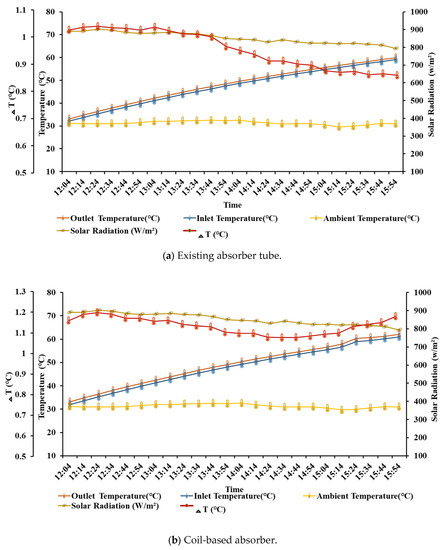
Figure 3.
Measured temperature variations and solar radiation in existing absorber tube (a) and coil-based absorber (b) using distilled water as heating medium (5 June 2020).
Similarly, in the case of nanofluid (CuO) as a heating medium, the thermal efficiency of the conical concentrating system was compared with and without coil-based absorbers under similar weather conditions. For the reference case, the solar collector performance was investigated with an existing absorber (without coil) and CuO nanofluid was used as a heating medium at flow rate 6 L/min. Under clear sky conditions, the time-based data of solar radiation, wind speed, and temperature were collected between 10:44 a.m. and 2:32 p.m. on 22 June 2020. the average values of solar radiation and ambient air temperature were found to be 832.6 W/m2 and 35.76 °C, respectively, and the wind speed varied in the range of 1.3–2 m/s. The solar radiation, water, and air temperatures were measured every minute and averaged over 10 min’ interval. For the existing absorber tube, the inlet and outlet temperatures of working fluids were increased from 33.7–68.09 °C and 34.65–69.1 °C, respectively. In the case of a coil-based absorber, the inlet and outlet temperatures of working fluids were increased from 32.9–70.8 °C and 33.4–71.95 °C, respectively, as shown in Figure 4.
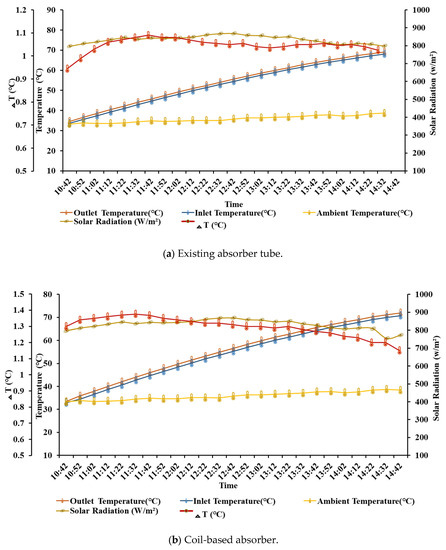
Figure 4.
Measured temperature variations and solar radiation in existing absorber tube (a) and coil-based absorber (b) using CuO-nanofluid as heating medium (22 June 2020).
Based on performance analysis, the maximum, average, and minimum thermal efficiencies of the conical solar collector with an existing absorber (without coil) were found to be 78.4%, 65.1%, and 53%, respectively. In the case of the coil-based absorber, the maximum, average, and minimum thermal efficiencies were found to be 81%, 72.2%, and 58.9%, respectively, as shown in Figure 5 and Table 3.
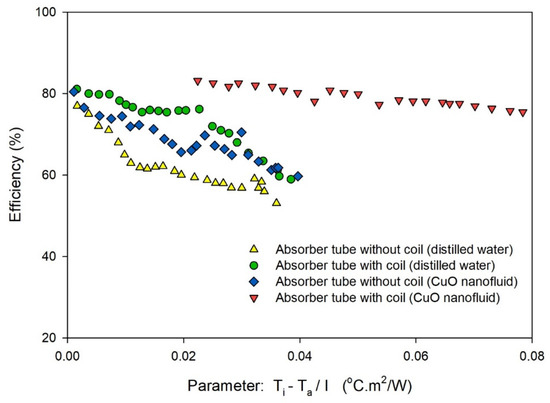
Figure 5.
Thermal efficiency analyses of absorber tube without coil and with coil using distilled water and CuO nanofluid as heating medium flowing at rate of 6 L/min.

Table 3.
Efficiency of absorber tube without coil and with coil using distilled water and CuO nanofluid as working medium.
It can be observed that there is a good correlation between instantaneous efficiency and (Ti − Tα)/I parameter at fixed flow rates of 6 L/min both in cases of existing absorber tube and coil-based absorber. In the case of the existing absorber tube, the average efficiency of the collector increased by 60.1~72.2% with distilled water. The reason for this increase in efficiency at fixed flow rate is due to the elongation of interaction time between the inner absorber surface and the fluid, which is important to an increase in circulating fluid temperature. The high-water temperature leads to more heat loss from the absorber surface than ambient temperature. While using CuO nanofluid in the existing absorber tube, it was found that minimum, average and maximum values of efficiencies were found to be 59.7%, 68.4%, and 80.45%, respectively. Therefore, on an average, using nanofluid, the efficiency of existing absorber tube was found to be 12% more than in the case of using distilled water. On the other side, using the coil-based absorber, the average heat collection efficiency was found to be 68.4% and 79.1% in the case of using distilled water and nanofluid, respectively. Similar to the existing absorber tube case, use of nanofluid gave better efficiency than that of distilled water. Comparing the existing and coil-based absorber, it can be observed that the coil-based absorber showed a 10.7% higher thermal efficiency than that of conventional absorber. It can be explained by the fact that the addition of coil inside the absorber has not only increased the retention time for the exchange of heat between the circulating fluid and the absorber surface, but also enhanced the overall heat transfer area, which ultimately resulted in an enormous thermal gain. This shows that a coil-based absorber using nanofluid as heating medium is good option for better thermal efficiency. It is important to note that the data for each case was taken from different days; therefore, the climatic conditions are different on each day. The inflection at 0.022 °C.m2/W point may be the result of abnormal variations of solar radiation in that span of time.
4. Cost Analysis
Figure 6 shows six months heating cost using electricity and these two cases of solar concentrator. For the months of October and March, the ambient temperature is normally higher than December and January (colder), so cost of electricity is lower and solar concentrator also perform well due to better availability of solar radiations. However, the heating cost due to electricity increased in colder months dye to drop in ambient temperature and existence of more cloudy days. The contribution of the solar absorber with both of its cases (with and without coil) in reducing heating cost is evident. Therefore, economically, it would be the suitable option for space heating, especially in remote areas where the grid supply is limited or nonexistent due to high price of transmission and distribution infrastructure.
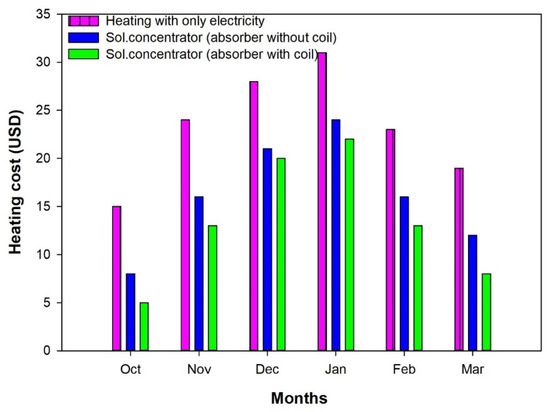
Figure 6.
Monthly heating cost using electricity and solar concentrating unit having absorber without coil and with coil.
For both the cases of absorber tube of the solar collector, payback periods and solar fractions are calculated as a function of flow rate of heating medium as tabulated in Table 4. It can be noted that with the increase of flow rate, the payback periods decreased and solar fractions increased for both the cases and found optimum at flow rate of 6 L per minute. Increasing the flow rate lead to higher heat transfer rate but exceeding the critical limit, i.e., 6 L/min, it started to decrease due to less retention time for the maximum of heat exchange between absorber heat and working medium. For the absorber tube without coil and with coil cases, the minimum payback periods were 14.5 and 11 years, respectively, and the maximum solar fractions were 0.4 and 0.52, respectively, at flow rate of 6 L/min. It can also be noted that for all the cases of flow rates, higher payback periods and lower solar fractions of the absorber tube without coil were calculated than that of respective parameters obtained with the addition of coil. The reasons for the lower payback period with higher solar fraction in the case of absorber with coil was due to the possibility of higher heat transfer rate. With the addition of coil, the heat transfer surface area increased, which facilitated better energy output. Such kinds of collectors can easily be used in other parts of the regions, but the heating efficiency and payback duration would definitely vary depending upon the existing solar radiation and climatic conditions.

Table 4.
Comparative cost analysis of solar concentrating system having absorber tube with and without a coil under different flow rates of heating medium.
5. Summary and Conclusions
The efficiency of the conical solar collector was analyzed, comparing the results: (1) between a new coil-based absorber and the existing standard absorber; (2) between CuO nanofluid and distilled water as working fluid. Independently of the heat medium, the new coil-based absorber is more efficient than the existing straight absorber tubes. The CuO nanofluid resulted in a higher efficiency for the whole thermal process because CuO collects heat better than water. The main results are: (1) Using distilled water the heat collection efficiency of the solar collector with coil-based absorber was 12.1% higher than that of the existing straight absorber while for the CuO nanofluid this increase was reduced to 10.7%. The coil-based absorber is clearly more efficient than the existing absorber (without coil). (2) A conical concentrating system with CuO nanofluid showed the highest heat collection efficiency. We believe using the CuO nanofluid as a working fluid is a valuable option when the high-temperature heat is concerned. (3) Since the CuO nanofluid has a higher heat transfer rate than distilled water, the efficiency is high, but heat loss is also massive, so further research on heat loss prevention is necessary to improve efficiency. (4) While the nanofluid circulates through the conical concentrating system, the dispersion stability is not maintained at the initial state, and as time passes, aggregation occurs, so there will be a decrease in efficiency. (5) Changing flow rate of heating medium was found to be a good way to obtain optimum solar fraction and payback period. The absorber tube with coil had a lower payback period and higher solar fraction than the absorber tube without coil at optimum flow rate of 6 L per minute. The contribution of solar absorber to reduce heating expenses in both of its cases (with and without coil) is obvious. Therefore, economically, it is good to use for space heating especially in areas, having poor grid connectivity.
Author Contributions
Conceptualization, H.A.M.A.; methodology, H.A.M.A.; formal analysis, H.A.M.A. and M.I.H.; investigation, H.A.M.A. and M.I.H.; resources, G.H.L.; data curation, H.A.M.A. and M.I.H.; writing—original draft preparation, H.A.M.A. and M.I.H.; writing—review and editing, M.I.H., W.A. and A.A.; visualization, M.I.H. and G.H.L.; supervision, G.H.L.; project administration, G.H.L.; funding acquisition, G.H.L. All authors have read and agreed to the published version of the manuscript.
Funding
This work was supported by the Korea Institute of Planning and Evaluation for Technology in Food, Agriculture, and Forestry (IPET) through the Technology Commercialization Support Program, funded by the Ministry of Agriculture, Food, and Rural Affairs (MAFRA) (No. 821048-3).
Institutional Review Board Statement
Not applicable.
Informed Consent Statement
Not applicable.
Data Availability Statement
Data sharing is not applicable.
Conflicts of Interest
The authors declare no conflict of interest. The funders had no role in the design of the study; in the collection, analyses, or interpretation of data; in the writing of the manuscript, or in the decision to publish the results.
Nomenclature
| nanoparticles concentration | |
| the thermal conductivity of the nanofluid (W/m⋅K) | |
| thermal conductivities of the nanoparticles (W/m⋅K) | |
| thermal conductivities of base fluid (W/m⋅K) | |
| useful energy (W) | |
| mass flow rate (kg/s) | |
| specific heat (J/kg°C) | |
| the outlet temperature of the thermal fluid (°C) | |
| the inlet temperature of the thermal fluid (°C) | |
| ambient temperature (°C) | |
| thermal efficiency | |
| Beam radiation (W/m2) | |
| collector area (m2) | |
| h | convective heat transfer coefficient (W/(m2K)) |
| Temperature difference between the absorber and ambient air (°C) |
References
- WBA. Global Bioenergy Statistics 2019; World Bioenergy Association: Stockholm, Sweden, 2019. [Google Scholar]
- Hasanuzzaman, M.; Rahim, N.A.; Saidur, R.; Kazi, S.N. Energy savings and emissions reductions for rewinding and replacement of the industrial motor. Energy 2011, 36, 233–240. [Google Scholar] [CrossRef]
- Hasanuzzaman, M.; Rahim, N.A.; Hosenuzzaman, M.; Saidur, R.; Mahbubul, I.M.; Rashid, M.M. Energy savings in the combustion-based process heating in the industrial sector. Renew. Sustain. Energy Rev. 2012, 16, 4527–4536. [Google Scholar] [CrossRef]
- Dincer, I.; Rosen, M.A. A worldwide perspective on energy, environment, and sustainable development. Int. J. Energy Res. 1998, 22, 1305–1321. [Google Scholar] [CrossRef]
- Colombo, U. Development and the global environment. In The Energy—Environment Connection; Hollander, J.M., Ed.; Island Press: Washington, DC, USA, 1992; pp. 3–14. [Google Scholar]
- Phuangpornpitak, N.; Kumar, S.P.V. Hybrid systems for rural electrification in Thailand. Renew. Sustain. Energy Rev. 2007, 11, 1530–1543. [Google Scholar] [CrossRef]
- Stryi-Hipp, G.; Weiss, W.; Mugnier, D.; Dias, P. Strategic Research Priorities for Solar Thermal Technology; European Technology Platform on Renewable Heating and Cooling: Brussels, Belgium, 2012. [Google Scholar]
- Zambolin, E.; Del Col, D. Experimental analysis of the thermal performance of flat plate and evacuated tube solar collectors in stationary standard and daily conditions. Sol. Energy 2010, 84, 1382–1396. [Google Scholar] [CrossRef]
- Zhai, H.; Dai, Y.; Wu, J.; Wang, R.; Zhang, L. Experimental investigation and analysis on a concentrating solar collector using linear Fresnel lens. Energy Convers. Manag. 2010, 51, 48–55. [Google Scholar] [CrossRef]
- Hussain, M.I.; Ali, A.; Lee, G.H. Performance and economic analyses of linear and spot Fresnel lens solar collectors used for greenhouse heating in South Korea. Energy 2015, 90, 1522–1531. [Google Scholar] [CrossRef]
- Zhao, C.; You, S.; Wei, L.; Gao, H.; Yu, W. Theoretical and experimental study of the heat transfer inside a horizontal evacuated tube. Sol. Energy 2016, 132, 363–372. [Google Scholar] [CrossRef]
- Na, M.S.; Hwang, J.Y.; Hwang, S.G.; Lee, J.H.; Lee, G.H. Design and Performance Analysis of Conical Solar Concentrator. J. Biosyst. Eng. 2018, 43, 21–29. [Google Scholar]
- Hwang, J.R. Experimental and Numerical Analysis for Performance Analysis of Conical Solar Heat Collecting System. Master’s Thesis, Kangwon National University, Chuncheon, Korea, 2018. [Google Scholar]
- Sakhrieh, A.; Ghandoor, A.A.L. Experimental investigation of the performance of five types of solar collectors. Energy Convers. Manag. 2013, 65, 715–720. [Google Scholar] [CrossRef]
- Kumar, R.; Rosen, M.A. Thermal performance of integrated collector storage solar water heater with corrugated absorber surface. Appl. Eng. 2010, 30, 1764–1768. [Google Scholar] [CrossRef]
- Tao, Y.B.; He, Y.L.; Cui, F.Q.; Lin, C.H. Numerical study on coupling phase change heat transfer performance of solar dish collector. Sol. Energy 2013, 90, 84–93. [Google Scholar] [CrossRef]
- Tiago, O.; João, C.M. Testing of solar thermal collectors under transient conditions. Energy Procedia 2012, 30, 1344–1353. [Google Scholar]
- Smith, P.D. Solar Collector with Conical Element. U.S. Patent US 4,030,477, 21 May 1977. [Google Scholar]
- Turk, T.I.; Dursun, P.; Cevdet, A. Development and testing of a solar air-heater with conical concentrator. Renew. Energy 2004, 29, 263–275. [Google Scholar] [CrossRef]
- Hussain, M.I.; Lee, G.H.; Kim, J.T. Experimental validation of mathematical models of identical aluminum and stainless steel engineered conical solar collectors. Renew. Energy 2017, 112, 44–52. [Google Scholar] [CrossRef]
- Hussain, M.I.; Lee, G.H. Numerical and experimental heat transfer analyses of a novel concentric tube absorber under non-uniform solar flux condition. Renew. Energy 2017, 103, 49–57. [Google Scholar] [CrossRef]
- Sabharwall, P.; Utgikar, V.; Gunnerson, F. Effect of mass flow rate on the convective heat transfer coefficient: Analysis for constant velocity and constant area case. Nucl. Technol. 2009, 166, 197–200. [Google Scholar] [CrossRef]
- Tomlinson, C.E. Nuclear Power Plant Thermodynamics, and Heat Transfer, 1st ed.; Iowa State University Press: Ames, IA, USA, 1989. [Google Scholar]
- Abdalha Mahmood, A.H.; Hussain, M.I.; Lee, G.H. Effects of Nanofluids in Improving the Efficiency of the Conical Concentrator System. Energies 2022, 15, 28. [Google Scholar] [CrossRef]
Publisher’s Note: MDPI stays neutral with regard to jurisdictional claims in published maps and institutional affiliations. |
© 2022 by the authors. Licensee MDPI, Basel, Switzerland. This article is an open access article distributed under the terms and conditions of the Creative Commons Attribution (CC BY) license (https://creativecommons.org/licenses/by/4.0/).